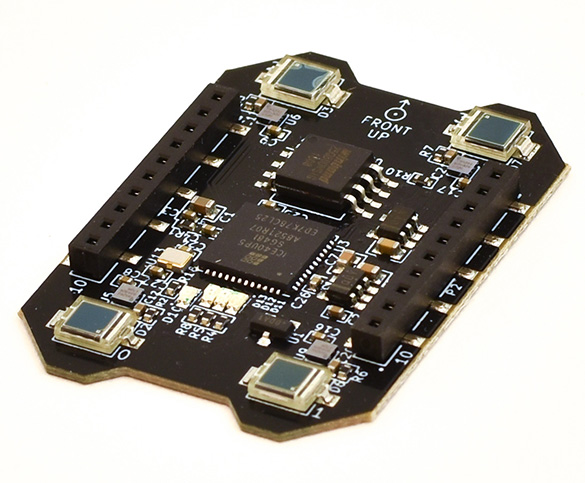
High precision positioning
How it works
With Crazyflie and the Lighthouse positioning deck , high precision autonomous flight becomes available for everyone. The Lighthouse deck uses the HTC Vive base stations (aka Lighthouse V1) or SteamVR Base Station 2.0 (aka Lighthouse V2) to achieve high precision positioning. The deck has 4 receivers which gives the full pose of the Crazyflie.
The position and pose is calculated directly in the Crazyflie, which makes it possible to create fully autonomous systems without external communication.
On-board position calculation and low complexity makes it the ideal choice for everything from big laboratories to small classrooms.
Specifications
Features
- High accuracy positioning
- Supports HTC Vive Base Station
- HTC Vive Base Station 2.0 support in development, possible with firmware update
- On-board FPGA for signal processing with open source toolchain
- UART and I2C bootloader to program the FPGA configuration
Mechanical specifications
- Weight: 2.7g
- Size (WxHxD): 27x39x3.5mm
- Designed for mounting on top of the Crazyflie 2.x
Electrical specification
- ICE40UP5K FPGA for signal processing
- 1-wire memory for automatic expansion deck detection
- 4 TS4231 IR receivers
- UART and I2C communication to Crazyflie deck expansion port
- UART pads available to solder a 2.54mm pin header for connection to external system, eg. Arduino (NOTE Max signal level 3V!)
- Typical current consumption 30mA
Compatibility
Usage
Go to the getting started tutorial of the lighthouse positioning system. Also for more general information over how the crazyflie fits in our positioning systems in general, go to Positioning Systems Overview.
General Information
Tutorials
Development
Firmware Implementation
All the Lighthouse positioning is estimated onboard of the crazyflie. Go the the technical documentation of the lighthouse positioning system of it is implemented into the Crazyflie Firmware.
It is important to have a good feel for the stabilizer module of the crazyflie, in particular state estimation with the Extended Kalman Filter
Hardware Hack: Using a LH deck with other hardware
The deck has 4 solder pad on the bottom that are designed to make it possible to use the Lighthouse positioning deck with other hardware. The 4 pads are labeled and corresponds to the connector P3 in the deck schematic.
The pads GND and VCOM can be used to supply power to the deck. There is a 3.0V LDO regulator on the board which means that VCOM can be in the range of ~3.3V to 5.5V.
RX and TX are connected directly to the iCE40LP5K FPGA. The FPGA is quite sensitive and the maximum voltage that can be applied to these pins is 3.2V, applying more than that will damage the FPGA. This makes the deck incompatible with 3.3V system out of the box, but adding a voltage-divider before RX and making sure there is never a pull-up to TX would be enough to interface the deck with a 3.3V system.
The deck boots in bootloader mode , the external system is responsible to update the bitstream if necessary and boot the board using the serial port.
Note: there is no software support for using the Lighthouse positioning deck with other hardware.
Resources
- Lighthouse positioning information
- Start here
- FAQ
- Getting help
- Expansion decks of the Crazyflie 2.x
- Datasheet
- Schematics
If you have any further questions please contact support@bitcraze.io